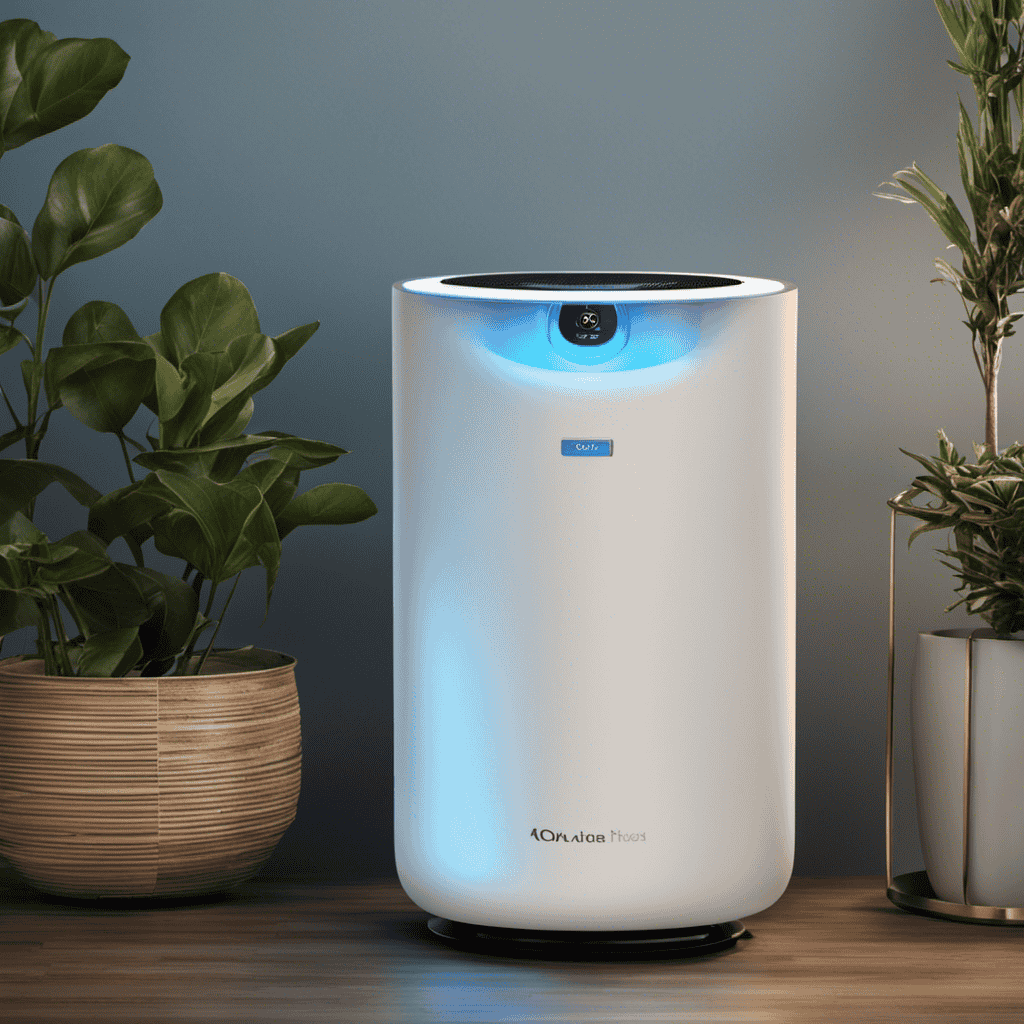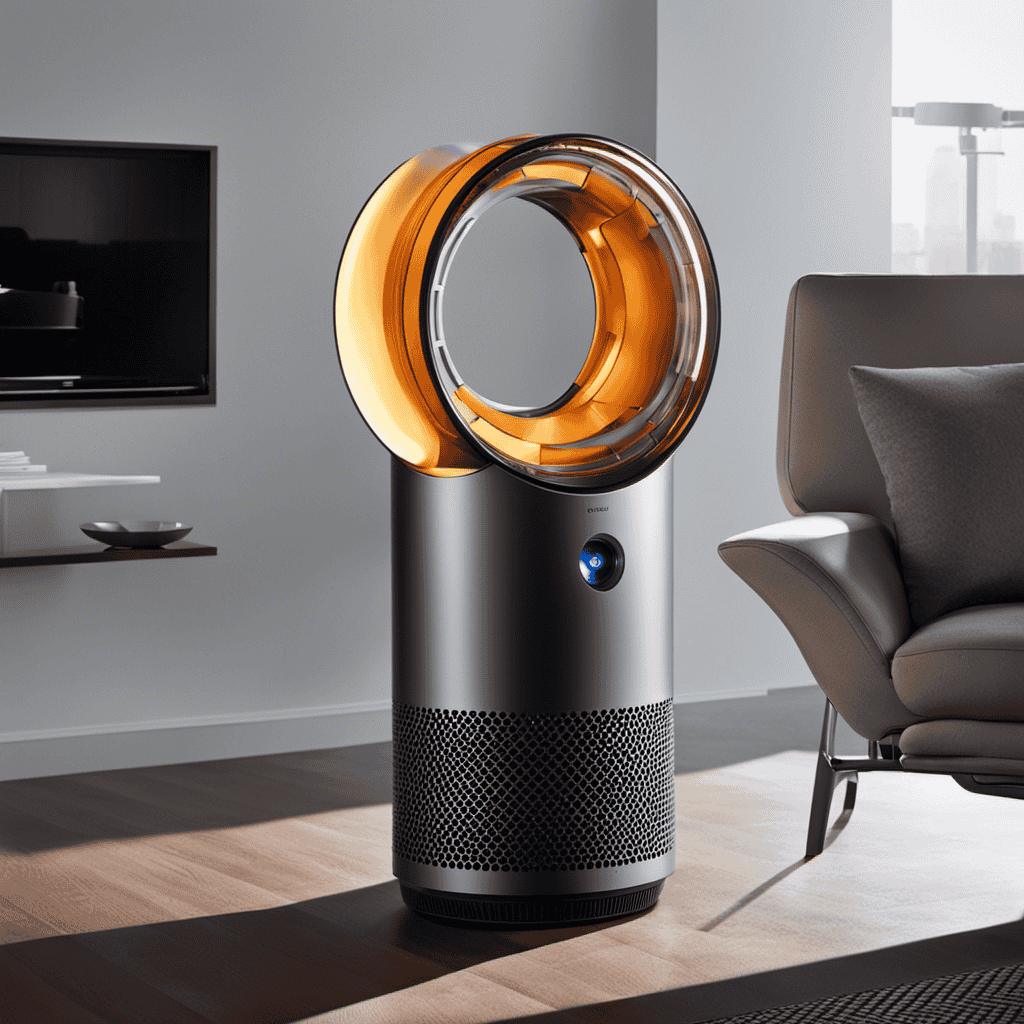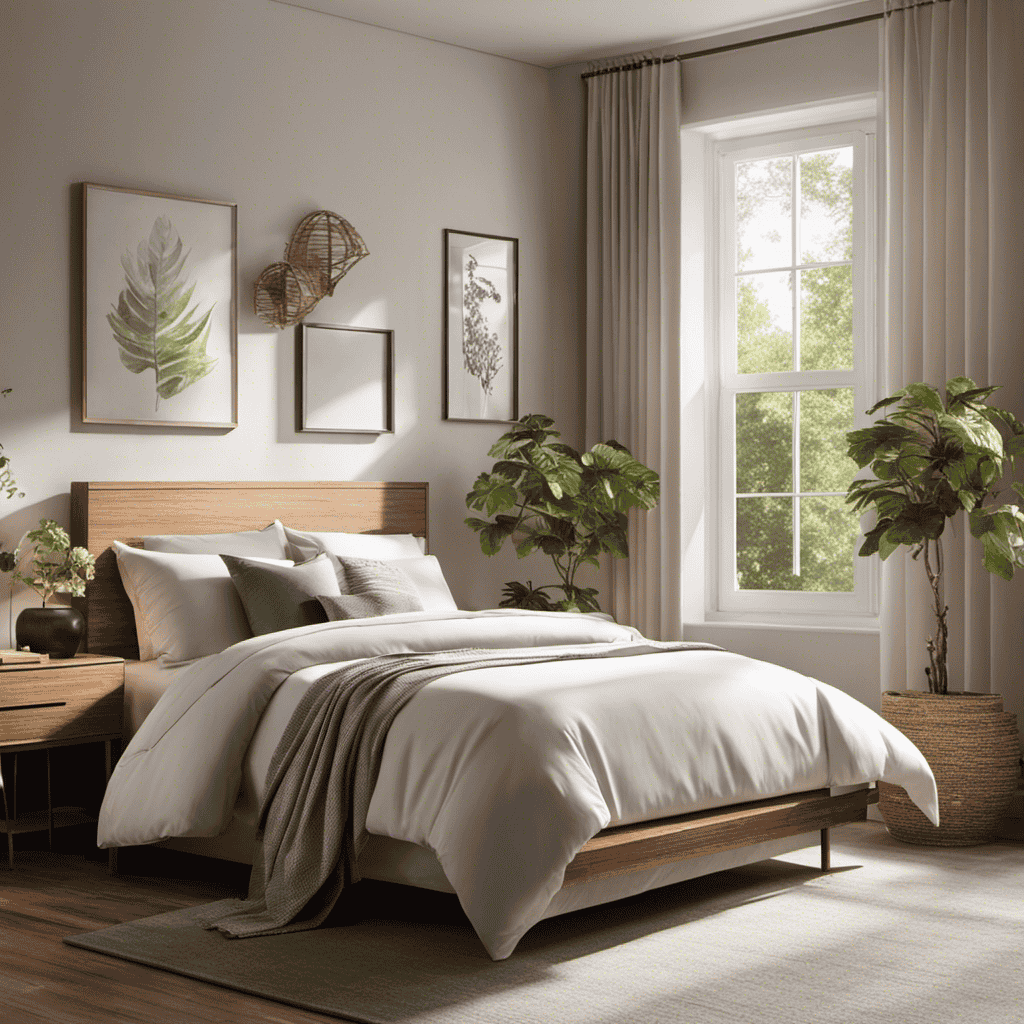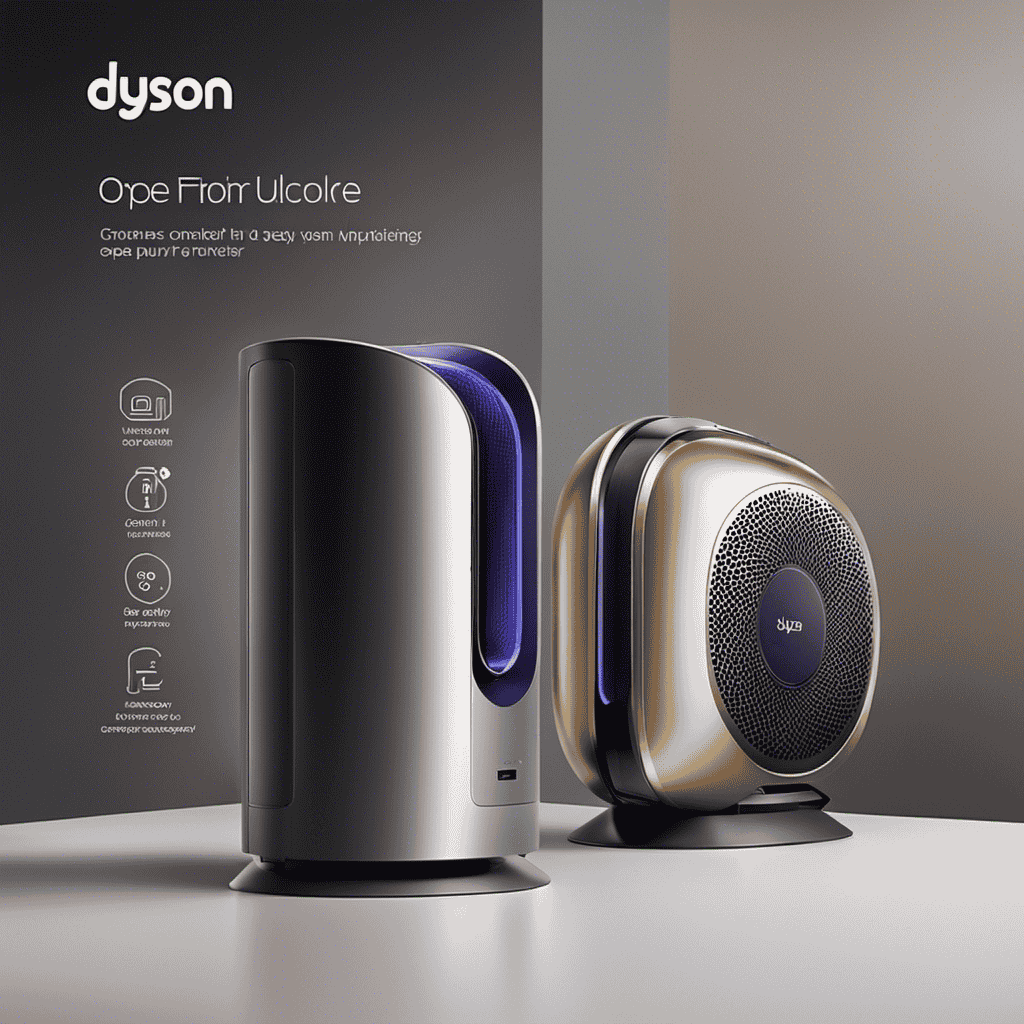As someone who’s passionate about air purifiers, I’ve always wondered about the enigmatic ion button on my machine. What is its precise function?
Well, in this article, we’ll unravel the science behind air ionization and explore the benefits of using this feature. By understanding the role of negative ions in improving air quality and debunking common misconceptions, you’ll be equipped to choose the right air purifier with an ionization feature.
So, let’s embark on this enlightening journey to discover the power of the ion button on an air purifier.
Key Takeaways
- The ion button on an air purifier releases negatively charged ions into the air.
- These ions attach to airborne particles, making them heavier and causing them to settle out of the air.
- The ion button helps improve air quality by reducing the presence of allergens, pollutants, and harmful substances.
- Regular maintenance and precautions are necessary for the safe and effective use of the ion button.
The Science Behind Air Ionization
You might be wondering how air ionization works and what it does for your air purifier.
Air ionization is a process that involves the production and release of negative ions into the air. Negative ions are molecules that have gained an extra electron, giving them a negative charge. These ions are naturally occurring in outdoor environments, particularly near waterfalls and forests, where they contribute to the fresh and clean air we experience.
Air purifiers with ionization capabilities replicate this natural process by releasing negative ions into the air. These ions attach themselves to airborne particles, such as dust, pollen, and pet dander, making them heavier and causing them to settle out of the air. This helps to improve air quality and reduce the presence of allergens and other pollutants.
Now that we understand the science behind air ionization, let’s explore how the ion button works.
How Does the Ion Button Work
The ion button on an air purifier offers numerous benefits when it comes to improving indoor air quality. It works by releasing negatively charged ions into the air, which attach to airborne particles and make them too heavy to stay afloat, causing them to fall to the ground.
This process effectively reduces the presence of allergens, pollutants, and other harmful substances in the air.
However, it is important to consider the effectiveness and safety of using the ion button, as there are certain limitations and potential risks associated with its use.
Ion Button Benefits
One of the benefits of pressing the ion button on an air purifier is that it helps to remove airborne particles more effectively. The ion button operation utilizes ion button technology, which releases negatively charged ions into the air.
These ions attach themselves to positively charged particles such as dust, allergens, and smoke, causing them to become heavier and fall to the ground. As a result, the air in the room becomes cleaner and fresher.
The ion button technology also helps to neutralize odors by binding with odor-causing molecules and eliminating them from the air. Furthermore, the ion button can improve the overall air quality by reducing the presence of airborne bacteria and viruses.
Overall, utilizing the ion button on an air purifier can significantly enhance the purification process and create a healthier living environment.
Ion Button Effectiveness
Pressing the ion button on an air purifier can effectively remove airborne particles and improve air quality in a room. When activated, the ion button releases negatively charged ions into the air. These ions attach to positively charged particles such as dust, pollen, and pet dander, causing them to become heavier and fall to the ground or stick to surfaces.
This process, known as ionization, can significantly reduce the number of airborne particles in the room. However, it’s important to note that there are some drawbacks to using the ion button. For example, it can produce ozone, which can be harmful in high concentrations. Additionally, regular maintenance is required to ensure the ionizer is functioning properly, such as cleaning the ionizing wires or plates to prevent buildup.
Overall, while the ion button can be effective in improving air quality, it is essential to be aware of its drawbacks and perform regular maintenance to ensure its safe and efficient operation.
Ion Button Safety
Activated, the ion button on an air purifier can release ozone, which can be harmful in high concentrations. It is important to consider the safety aspects of using the ion button to ensure a healthy indoor environment. Here are some key points to keep in mind:
-
Ion button maintenance:
-
Regular cleaning of the ionizing wires is necessary to maintain optimal performance and prevent buildup of pollutants.
-
Follow the manufacturer’s instructions for cleaning and replacing any filters or components associated with the ion button.
-
Ion button alternatives:
-
If you are concerned about ozone emissions, look for air purifiers that offer alternative technologies such as activated carbon filters, HEPA filters, or UV-C light to capture and eliminate airborne pollutants.
-
Consider using the ion button sparingly or in conjunction with other filtration methods to minimize ozone exposure.
By understanding the potential risks and taking proper precautions, you can ensure the safe and effective use of the ion button on your air purifier.
Now, let’s explore the benefits of using the ion button.
Benefits of Using the Ion Button
When it comes to the effectiveness of the ion button on air purifiers and its potential health benefits, there are several key points to consider.
The ion button works by releasing negatively charged ions into the air which attach to and neutralize airborne particles, such as dust, pollen, and pet dander.
This can help improve indoor air quality and reduce the presence of allergens, potentially providing health benefits for individuals with respiratory conditions or allergies.
Ion Button Effectiveness
To maximize the effectiveness of the ion button on your air purifier, try leaving it on for longer periods of time. According to ion button research, extended usage allows for more ions to be released into the air, helping to remove pollutants and improve air quality.
In addition to leaving the ion button on for longer, regular maintenance is also crucial for optimal performance. Here are some key maintenance tips:
- Clean the ionizer plates regularly to remove any buildup or residue that may hinder ion production.
- Replace the ionizer plates as recommended by the manufacturer to ensure efficient ionization.
Potential Health Benefits?
By regularly maintaining your device and leaving it on for longer periods, you can potentially experience improved health benefits from your air purifier. While air purifiers are primarily known for their ability to remove pollutants and allergens from the air, they can also have additional advantages for your health. Studies have shown that using an air purifier can potentially reduce the risk of respiratory infections, allergies, and asthma symptoms. Additionally, the continuous filtration of air can help improve sleep quality and overall well-being. However, it is important to note that the long-term effects of using an air purifier have not been extensively studied, and there may be potential health risks associated with prolonged exposure to certain types of air pollutants. Therefore, it is crucial to choose a high-quality air purifier and follow the manufacturer’s instructions for optimal use.
| Potential Health Benefits of Air Purifiers |
|---|
| Reduced risk of respiratory infections |
| Alleviation of allergies and asthma symptoms |
| Improved sleep quality |
| Enhanced overall well-being |
Understanding Negative Ions and Air Quality
Understanding negative ions can help you improve the air quality in your home. Negative ions are molecules or atoms that have gained an extra electron, giving them a negative charge. They are naturally found in nature, especially near waterfalls, forests, and beaches.
When negative ions are released into the air, they attach to pollutants such as dust, allergens, and bacteria, causing them to become heavier and fall to the ground. This process, known as air purification, helps to remove these harmful particles from the air you breathe.
The benefits of negative ions on air quality include reducing airborne allergens, improving respiratory health, and promoting a sense of well-being. By understanding the role of negative ions in air purification, you can make informed decisions on how to improve the air quality in your home.
- Negative ions attach to pollutants, making them heavier and causing them to fall to the ground.
- Air purification through negative ions reduces airborne allergens, improving respiratory health.
- Studies have shown that negative ions can help alleviate symptoms of allergies and asthma.
- Negative ions promote a sense of well-being, improving mood and overall health.
- They have been found to increase serotonin levels, which can help reduce stress and anxiety.
Potential Health Effects of Air Ionization
Potential health effects of air ionization include improved respiratory function, reduced stress and anxiety, and increased overall well-being. Research on air ionization has shown promising results in these areas.
When air molecules are ionized, they become charged, and these charged particles can interact with our bodies in various ways. One potential risk of air ionization is the production of ozone, which can irritate the respiratory system and worsen respiratory conditions. However, modern air purifiers with ionization features have advanced technology to minimize ozone production.
It is important to note that more research is needed to fully understand the long-term effects of air ionization on human health. In the meantime, it is recommended to use air ionization features in moderation and to consult with healthcare professionals if you have specific health concerns.
Ionization Vs. HEPA Filtration: Which Is Better
When it comes to choosing between ionization and HEPA filtration, you may be wondering which option is better for improving indoor air quality. Both ionization and HEPA filtration have their pros and cons, and it ultimately depends on your specific needs and preferences.
Ionization is a process that uses electrically charged particles to remove contaminants from the air. It can be effective in reducing airborne particles such as dust, pollen, and pet dander. However, it does not effectively remove gases, odors, or volatile organic compounds (VOCs).
On the other hand, HEPA filtration is highly efficient in removing particles as small as 0.3 microns in size. It can effectively capture allergens, bacteria, and viruses, providing cleaner and healthier air. However, it does not remove gases or odors.
In comparison to UV C light, ionization is generally considered to be more effective in reducing airborne particles. However, when it comes to removing gases and odors, activated carbon filters are more efficient than ionization. Therefore, if your primary concern is reducing particles, ionization may be a better option. But if you also want to eliminate gases and odors, activated carbon filters are the way to go.
Tips for Using the Ion Button Effectively
Now that we have discussed the differences between ionization and HEPA filtration, let’s dive into some tips for using the ion button effectively on your air purifier.
To ensure that your ionization feature operates optimally, regular maintenance is crucial. It is recommended to clean the ion button periodically, as dust and debris can accumulate and hinder its performance. This can be done by gently wiping the button with a soft, dry cloth.
If you encounter any issues with the ion button, troubleshooting steps can be taken. First, check the power supply and ensure it is properly connected. If the issue persists, consult the user manual for further guidance or contact the manufacturer’s customer support.
By following these maintenance and troubleshooting tips, you can make the most out of your air purifier’s ion button.
Now, let’s explore some common misconceptions about air ionizers.
Common Misconceptions About Air Ionizers
Don’t be fooled by common misconceptions about how ionizers work. Ionizers are often misunderstood, but they can offer potential health benefits when used correctly. Here are some important facts to consider:
-
Ionizers do not remove particles from the air: Contrary to popular belief, ionizers do not physically remove particles from the air. Instead, they release negative ions that attach to airborne particles, causing them to fall to the ground or stick to surfaces.
-
Ionizers can help with odor control: One of the main benefits of ionizers is their ability to neutralize odors. The negative ions they produce can bind to odor-causing molecules, eliminating unpleasant smells in the air.
-
Ionizers may have limited impact on allergies: While some people report relief from allergies when using ionizers, scientific evidence is inconclusive. Ionizers may reduce the presence of certain allergens in the air, but they are not a substitute for proper air filtration systems.
Understanding these common misconceptions about ionizers can help you make informed decisions about their use and potential health benefits.
Choosing the Right Air Purifier With Ionization Feature
It’s important to select the right purifier with ionization capabilities to ensure optimal air quality. When it comes to air purification, negative ions play a crucial role in improving the overall indoor environment.
These ions are produced by the purifier and help to neutralize harmful pollutants and allergens in the air. By attaching themselves to these particles, negative ions make them heavier, causing them to fall out of the air and onto surfaces. This process, known as ionization, effectively removes pollutants from the air, resulting in cleaner and healthier indoor air quality.
When choosing an air purifier with ionization feature, it’s essential to consider the size of the space, the level of purification needed, and the specific pollutants you want to target. By carefully selecting the right purifier, you can enjoy the benefits of negative ions and achieve optimal air purification.
Frequently Asked Questions
Can the Ion Button on an Air Purifier Be Turned Off?
Yes, the ion button on an air purifier can be turned off. While the benefits of the ionization feature include removing airborne particles, some people may prefer not to use it due to potential ozone emissions.
How Often Should the Ionization Feature Be Used on an Air Purifier?
The ionization feature on an air purifier should be used intermittently, as prolonged exposure to ions can have negative effects. It is not safe to use it continuously. It is recommended to follow the manufacturer’s instructions for optimal usage.
Can the Ionization Feature on an Air Purifier Remove All Types of Indoor Pollutants?
The ionization feature on an air purifier can remove a wide range of indoor pollutants. However, its efficiency may vary depending on the specific pollutants. It is important to consider the potential long-term effects of ionization on air quality.
Are There Any Potential Side Effects of Using the Ion Button on an Air Purifier?
Using the ion button on an air purifier may have potential risks. It’s important to consider the effectiveness of ionization in removing indoor pollutants and weigh it against any potential side effects.
Can the Ionization Feature on an Air Purifier Eliminate Odors in Addition to Pollutants?
The ionization feature on an air purifier can effectively eliminate odors in addition to pollutants. However, it’s important to consider the safety of ionization and potential side effects before using it.
Conclusion
In conclusion, the ion button on an air purifier is like a superhero fighting the invisible villains in our air.
With its magical powers of ionization, it creates negative ions that attract and neutralize harmful particles, leaving our air fresh and clean.
This incredible feature not only improves air quality but also has potential health benefits.
So, if you want to breathe in air that feels like a refreshing breeze on a sunny day, make sure to choose an air purifier with the ionization superpower!










